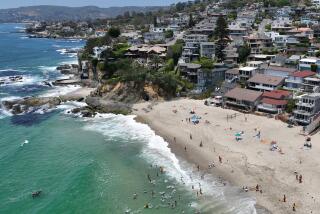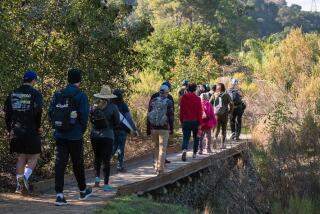Bolsa Chica Wetlands Restoration Approved
- Share via
The California Coastal Commission unanimously approved a $100-million plan Tuesday to restore the Bolsa Chica wetlands, cut off from the ocean a century ago, to their natural state.
Environmentalists and project planners jumped up to cheer as the commission made its decision, which represents the last major hurdle of a decades-long battle to restore the wetlands, home to such endangered birds as western snowy plovers and least terns. Still raging, however, is a separate battle over plans to build more than 300 homes on a bluff above the wetlands.
“This is a momentous day for us,” said Jack Fancher, a biologist for the U.S. Fish and Wildlife Service who was the main planner for the restoration project. “We are very, very happy to reach what is the de facto end of planning and the beginning of construction.”
The plan is the most expensive wetlands recovery project in the state’s history. It promises to turn the 1,200-acre coastal expanse of polluted salt marshes, mud flats, pools and oil rigs into a flourishing ecosystem of rare flora and fauna. It calls for cutting a 360-foot-wide inlet through the beach that lies between the ocean and the wetlands and building a traffic bridge over the inlet.
The commission’s 8-0 vote, which came after nearly two hours of discussion at the meeting in downtown Los Angeles, means that the Fish and Wildlife Service’s restoration plan conforms with the rules of the state’s landmark Coastal Act.
“I’m elated,” said Shirley Dettloff, a commissioner and Huntington Beach councilwoman who in 1976 was a founding member of Amigos de Bolsa Chica, formed to preserve and restore the site. “It’s the highlight of all the meetings we’ve had on Bolsa Chica.”
The project still needs approvals or permits from three other state and federal agencies, but is expected to win those easily. Work is expected to begin in 2003 and take about three years.
Once a flourishing coastal marsh, the Bolsa Chica wetlands were cut off from the ocean a century ago by duck hunters who filled a natural inlet to create better hunting conditions. Still, Bolsa Chica, meaning little pocket in Spanish, is the largest remaining wetlands complex in Southern California and a key stopover for migratory birds on the Pacific flyway.
Government officials, developers and environmentalists have been arguing for three decades over the wetlands, which almost became part of a major residential development and marina off Huntington Beach. The state stepped in four years ago and bought 880 acres for $25 million.
Officials from the federal wildlife service and a host of state and federal agencies have spent five years crafting the restoration plan. The inlet allowing ocean water into the wetlands is expected to raise the water levels and circulate the water more, helping several species of imperiled birds and fish.
The inlet proposal is not universally popular. Some people fear that opening up the wetlands will bring bacteria from the marshland into the ocean off Bolsa Chica State Beach, one of the cleaner coastal stretches in Orange County. Those opponents to the plan, many of whom are surfers, sent letters to the Coastal Commission but did not attend Tuesday’s meeting.
The tidal inlet will be carved through five acres of the idyllic state beach, which attracts more than 2 million visitors a year.
Wildlife officials have said that studies and experience elsewhere show that the beach’s water quality will be unaffected by the inlet.
The commission Tuesday put in place a requirement that if the ocean water is showing higher levels of bacteria, the commission can order changes to improve water quality.
Earlier this month, the commission’s staff recommended denying the project. The main reason was a six-lane bridge sought by the California Department of Transportation to replace a four-lane section of Pacific Coast Highway that would be razed to make way for the inlet.
But in an unexpected move, Caltrans stopped demanding a six-lane bridge to allow the project to move forward. That set the stage for Tuesday’s approval.
“We have a severely impaired ecosystem. It’s not dead,” said biologist Fancher. “There are parts still existing. We’re going to revive this patient and bring it back to full function.”
More to Read
Sign up for Essential California
The most important California stories and recommendations in your inbox every morning.
You may occasionally receive promotional content from the Los Angeles Times.











